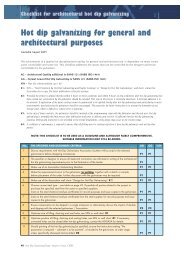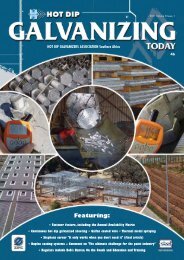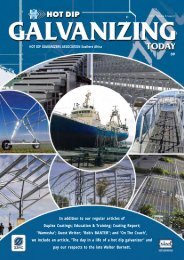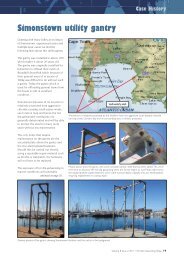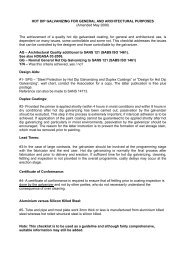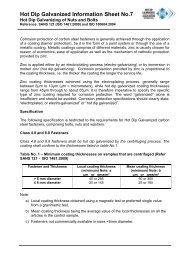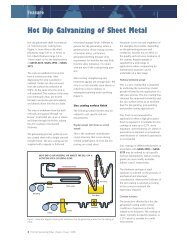Featuring: - hdgasa
Featuring: - hdgasa
Featuring: - hdgasa
You also want an ePaper? Increase the reach of your titles
YUMPU automatically turns print PDFs into web optimized ePapers that Google loves.
Coating Report<br />
nozzle pressure be not greater than<br />
300kPa #1 ; nozzle angle to the surface<br />
being cleaned – 30º- 60º; sweeping<br />
distance 450 - 600mm; abrasive–<br />
ultrafine non-metallic grit – not less<br />
than 0.2mm and not greater than<br />
0.8mm; grit should not be recycled #2 ;<br />
the blasted zinc surface must be free<br />
from all contaminants including oil and<br />
dust.<br />
#1 Nozzle blast pressure of below 300kPa is of<br />
extreme importance, especially when thick hot<br />
dip galvanized coatings are encountered. A thick<br />
hot dip galvanized coating is normally due to<br />
the reactivity of the steel when immersed in<br />
molten zinc and is caused mainly by the<br />
element silicon in the steel. The resultant thicker<br />
coating is normally devoid of the soft outer zinc<br />
(eta) layer and made up largely of iron/zinc<br />
alloys, which can be susceptible to mechanical<br />
damage, particularly on edges of the steel,<br />
noticeably seen after the components have been<br />
inappropriately handled during loading and<br />
transport. Conversely, the soft zinc or eta layer<br />
when correctly sweep blasted is easily fluffed up<br />
to provide a surface profile for subsequent<br />
painting. The soft zinc layer is also more<br />
forgiving when sweep blasting is done at<br />
excessive blast pressures.<br />
In order to ensure that correct sweep blasting is<br />
carried out, a needle valve indicating blast<br />
pressure, can be inserted through the blasting<br />
hose within easy visual distance of the operator.<br />
#2 Although the recycling of micro-grit is not<br />
recommended in the Code of Practice, an article<br />
appeared in Hot Dip Galvanizing Today No.<br />
27, which discusses the successful recycling of<br />
the grit when sweep blasting.<br />
Coating thickness (µm)<br />
Coating thickness readings taken at<br />
the galvanizer measured far in excess<br />
of that required by SANS 121, which<br />
requires that for steel thickness<br />
equal to and greater than 6mm the<br />
local coating thickness be a<br />
minimum of 70µm with a mean of at<br />
least 85µm. SANS 121 does not have<br />
a upper limit in prescribing the<br />
coating thickness. See 4 photos top left.<br />
Sweep blasting at the correct blast pressure will normally remove a maximum of about 10 to 20<br />
µm of the coating, judging by the residual coating thickness measured adjacent to the coating<br />
damage after sweep blasting, coating removal has been exceeded and in many areas, the coating<br />
has been damaged leaving a thin iron/zinc alloy layer of 24 to 35µm.<br />
Other comments<br />
The photos on the opposite page show<br />
the surface profile of the steel as a<br />
result of acceptable roll wear as<br />
commented by the steel producer (top)<br />
and the consequent appearance of the<br />
coating after hot dip galvanizing<br />
36 Hot Dip Galvanizing Today Volume 4 Issue 3 2007



